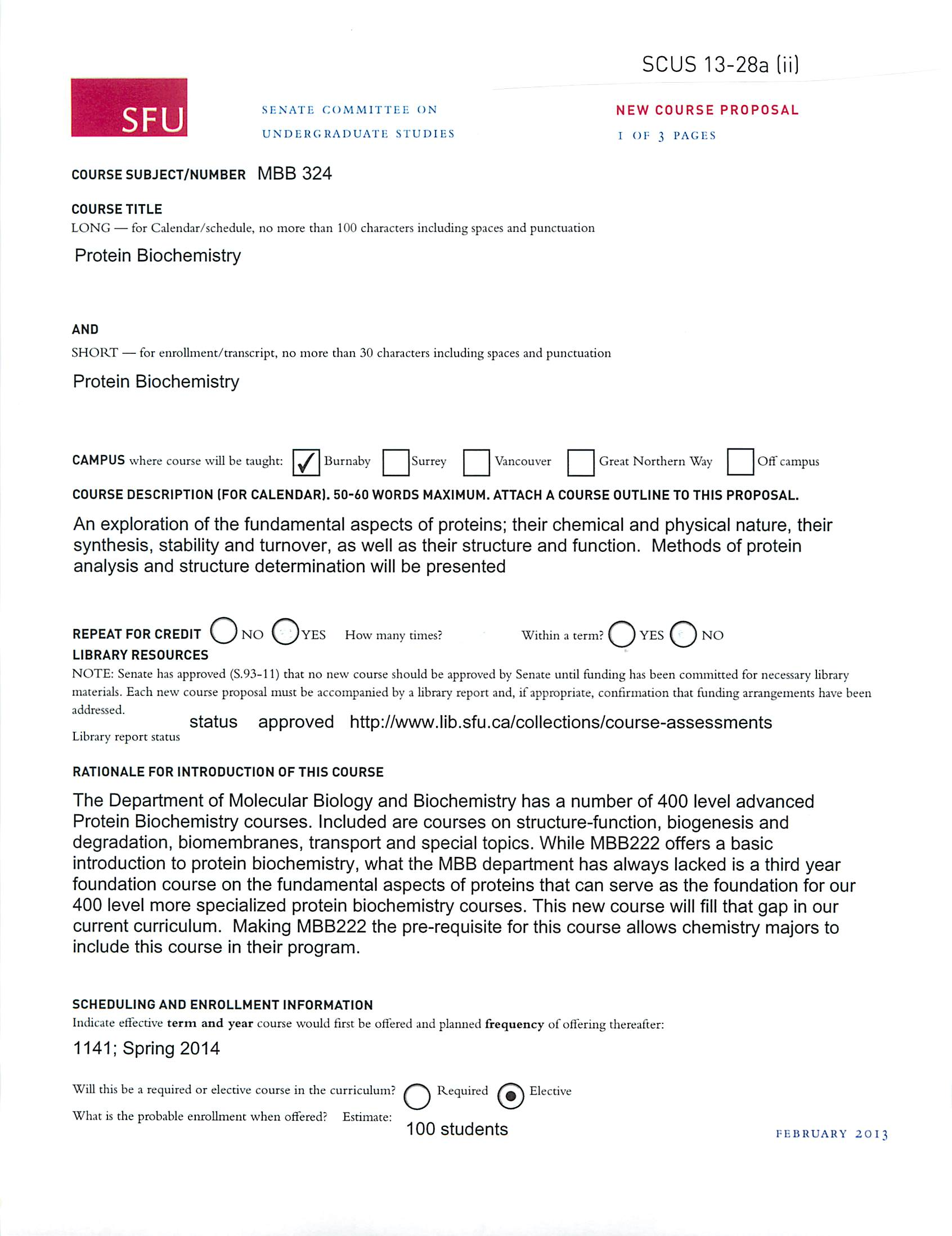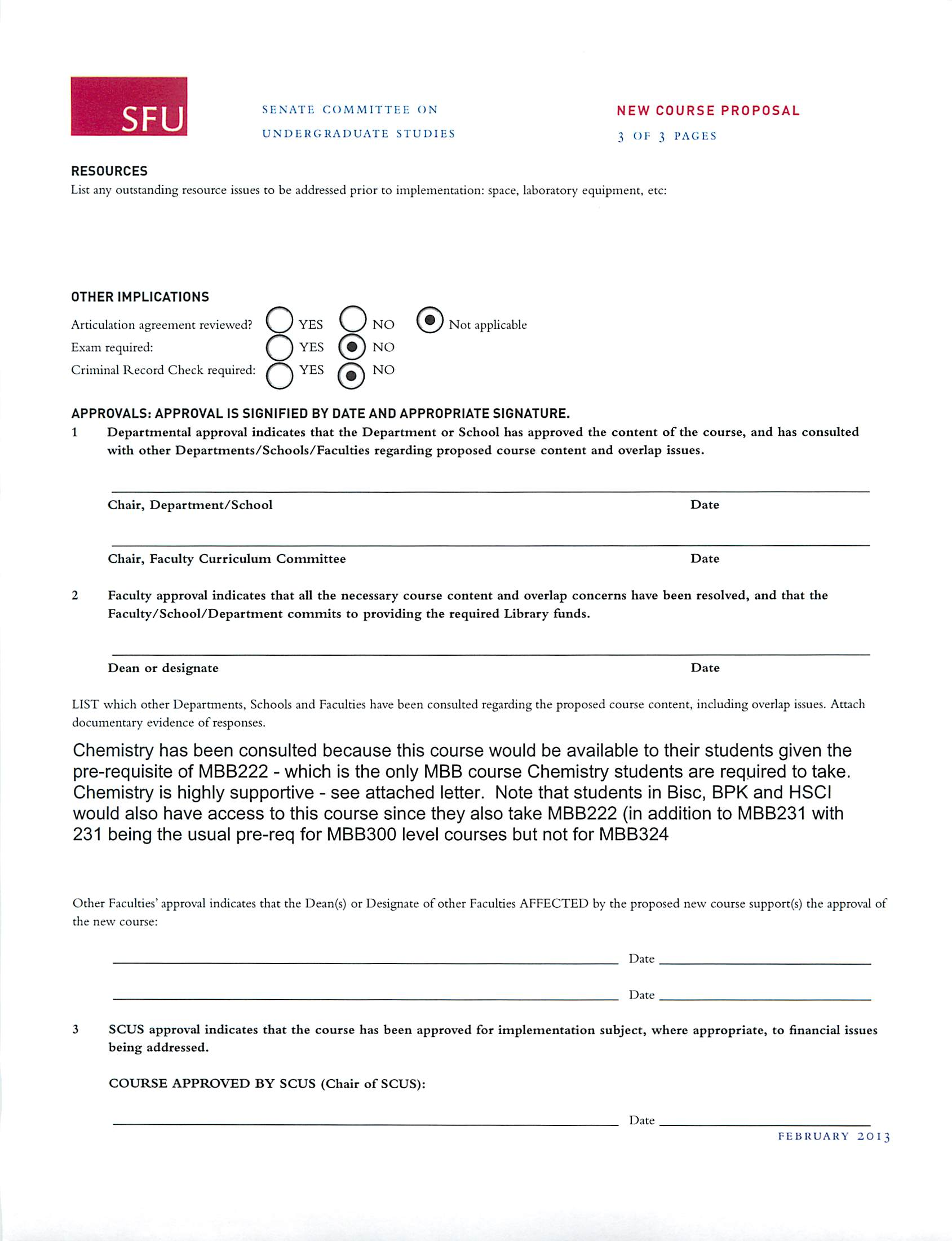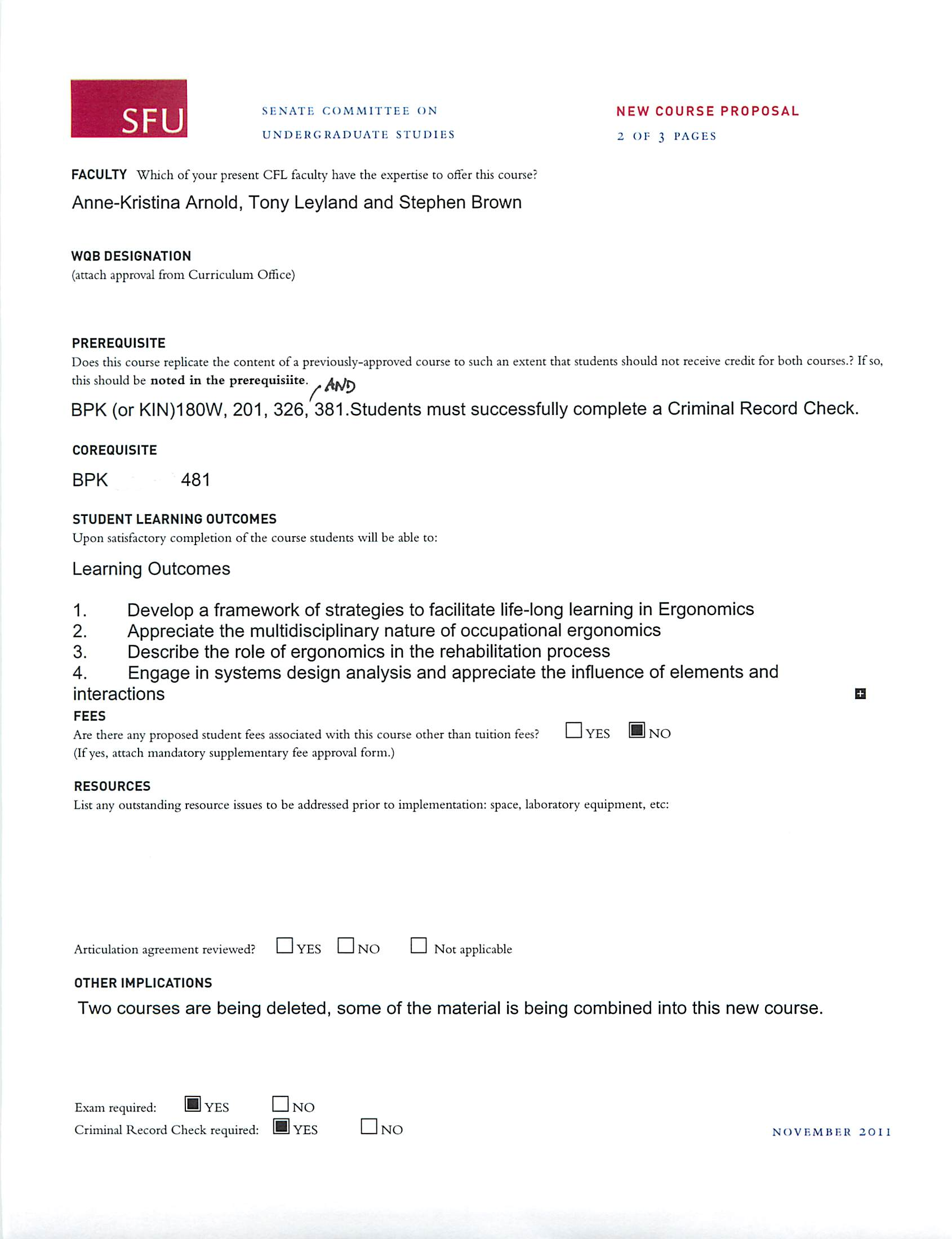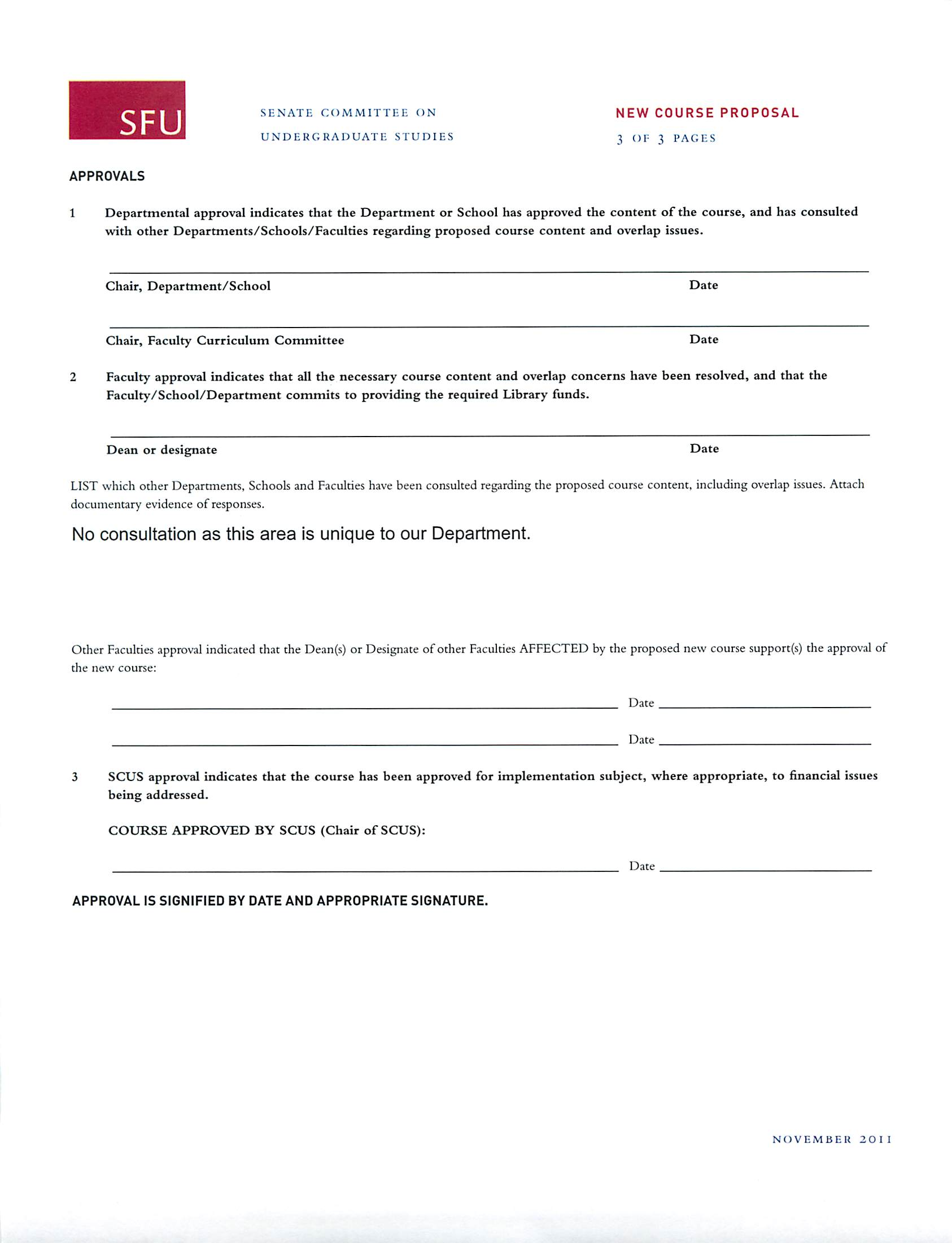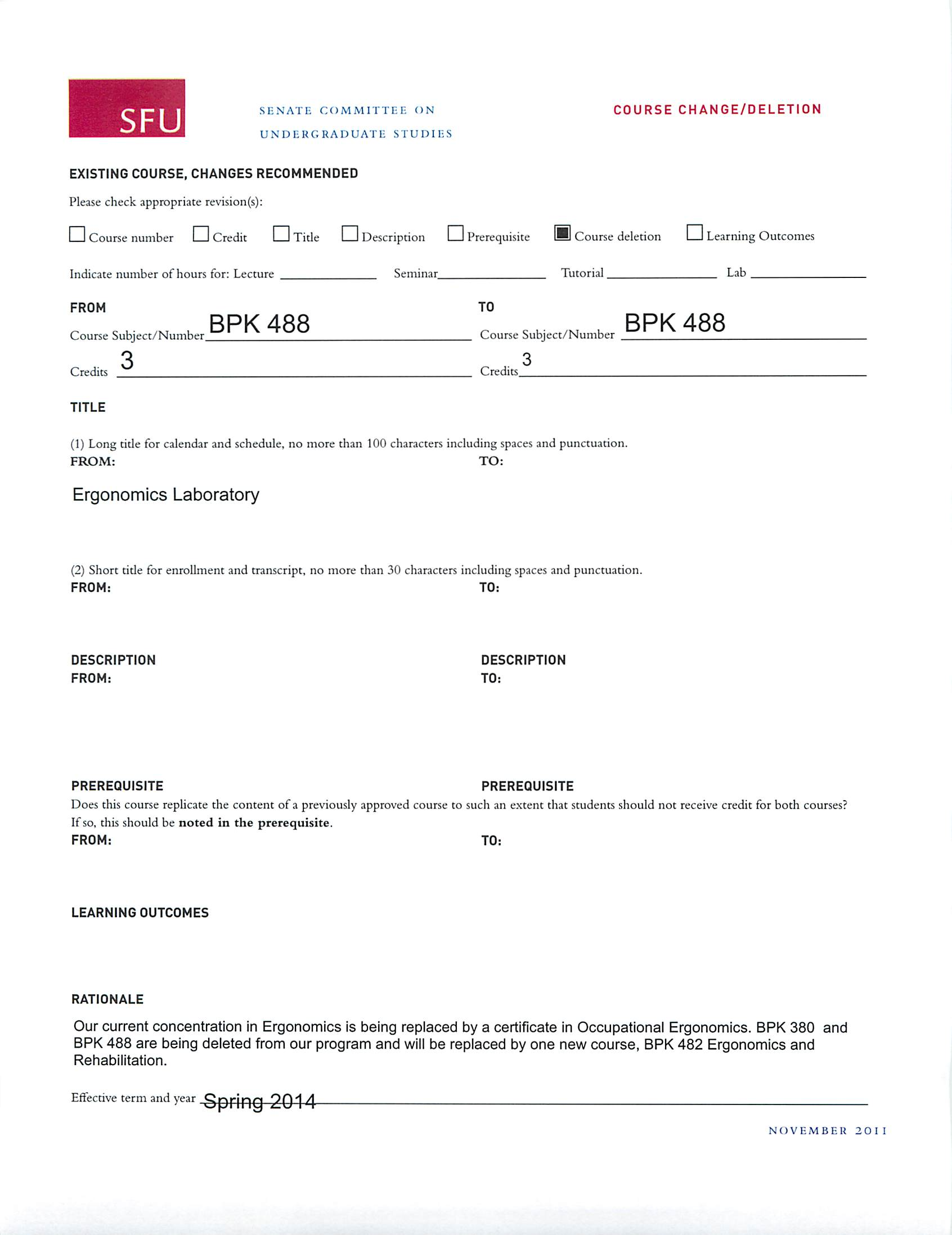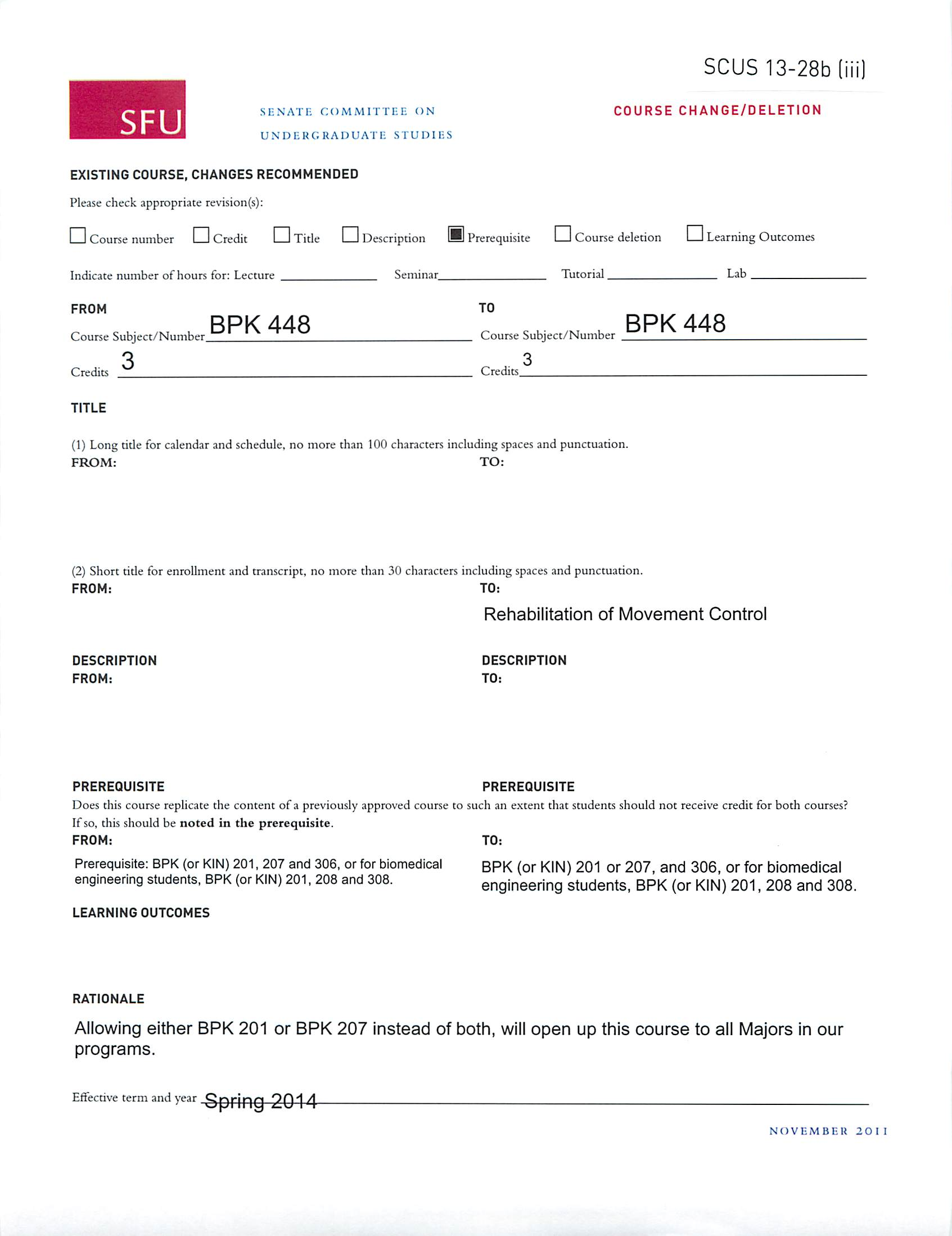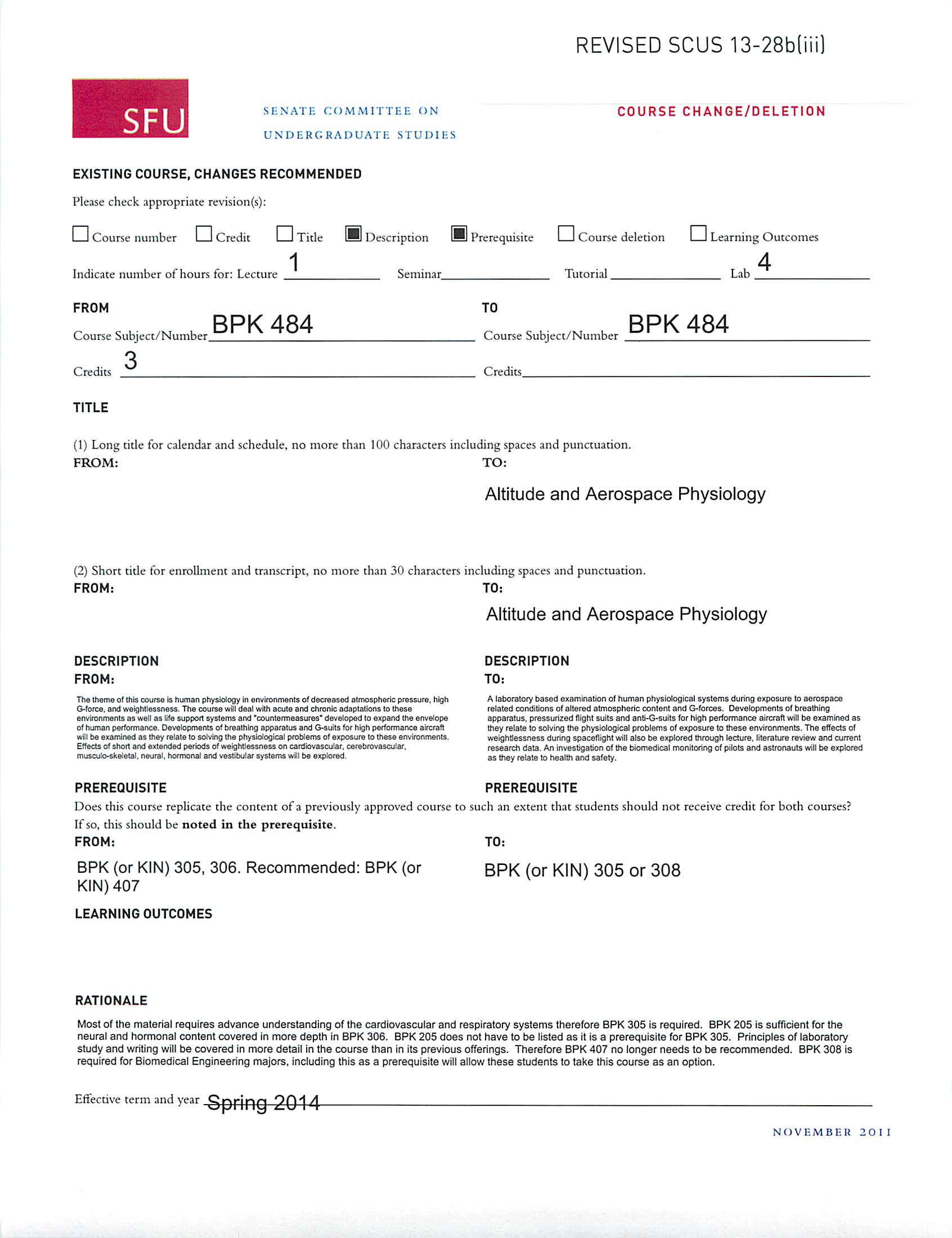SFU
OFFICE OF THE ASSOCIATE VICE-PRESIDENT, ACADEMIC
8888 University Drive,
TEL: 778.782.4636
avpciofdsfu.ca
Burnaby, BC
www.sfu.ca/vpacademic
Canada V5A1S6
MEMORANDUM
-
ATTENTION
Senate
DATE
June 7, 2013
FROM
Gordon Myers, Chair
PAGES
1/1
Senate Committee on
^y
Undergraduate Studies
|
JX^
RE:
Faculty of Science [SCUS 13-28)
^
,
For information:
Acting under delegated authority at its meeting of June 6, 2013, SCUS approved the
following curriculum revisions effective Spring 2014:
1. Department of Molecular Biology and Biochemistry [SCUS 13-28a)
li] New Course Proposal: MBB 324-3, Protein Biochemistry
2. Department of Biomedical Physiology and Kinesiology [SCUS 13-28b)
) New Course Proposal: BPK 482-3, Ergonomics and Rehabilitation
i) Deletion of BPK 380, 488
ii] Description and/or Prerequisite change to BPK 448, 484
SIMON FRASEB UNIVERSITY
engaging the world
S.13-102
SFU
SCUS13-28a (ii)
SENATE COMMITTEE ON
NEW COURSE PROPOSAL
UNDERGRADUATE STUDIES
\
OF 3 PAGES
COURSE SUBJECT/NUMBER MBB 324
COURSE TITLE
LONG — for Calendar/schedule, no more than 100 characters including spaces and punctuation
Protein Biochemistry
AND
SHORT — for enrollment/transcript, no more than 30 characters including spaces and punctuation
Protein Biochemistry
CAMPUS
where course will be taught:
.X Burnaby
Surrey
|
Vancouver
Great Northern Way
Off campus
COURSE DESCRIPTION (FOR CALENDAR). 50-60 WORDS MAXIMUM. ATTACH A COURSE OUTLINE TO THIS PROPOSAL.
An exploration of the fundamental aspects of proteins; their chemical and physical nature, their
synthesis, stability and turnover, as well as their structure and function. Methods of protein
analysis and structure determination will be presented
REPEAT FOR CREDIT
i^_J
NO (JyES
How many times?
Within aterm?
f~J
YES
f~J
NO
LIBRARY RESOURCES
NOTE: Senate hasapproved (S.93-11) that no new course shouldbe approved by Senate until funding hasbeen committed for necessary library
materials. Each new course proposal must be accompanied by a library report and, if appropriate, confirmation that funding arrangements have been
status approved http://www.lib.sfu.ca/collections/course-assessments
Library report status
RATIONALE FOR INTRODUCTION OF THIS COURSE
The Department of Molecular Biology and Biochemistry has a number of 400 level advanced
Protein Biochemistry courses. Included are courses on structure-function, biogenesis and
degradation, biomembranes, transport and special topics. While MBB222 offers a basic
introduction to protein biochemistry, what the MBB department has always lacked is a third year
foundation course on the fundamental aspects of proteins that can serve as the foundation for our
400 level more specialized protein biochemistry courses. This new course will fill that gap in our
current curriculum. Making MBB222 the pre-requisite for this
course allows chemistry majors to
include this course in their program.
SCHEDULING AND ENROLLMENT INFORMATION
Indicate effective
term and year
course would first be offered andplanned frequency of offering thereafter:
1141; Spring 2014
Will this be a required orelective course in the curriculum?
S~*\
Required
f^\
Elective
What is the probable enrollment when offered?
Estimate:
100 Students
February 2on
SFU
SENATE COMMITTEE ON
NEW COURSE PROPOSAL
UNDERGRADUATE STUDIES
2 OF 3 PAGES
CREDITS
Indicate number of credits (units):
three
Indicate number of hours for:
Lecture
Seminar
Tutorial
Lab
Other
three
one
FACULTY
Which of your present CFL faculty have the expertise to offer this course?
M. Paetzel, E. Young, L. Craig, R. Cornell, M. Leroux, P. Unrau, D. Sen, W. Davidson
WQB DESIGNATION
(attach approval from Curriculum Office)
none
PREREQUISITE
Does this course replicate the content of a previously-approved course to such an extent that students should not receive credit for both courses?
If so, this should be
noted in the prerequisite.
MBB222
COREQUISITE
none
STUDENT LEARNING OUTCOMES
Upon satisfactory completion of the course students will be able to:
Students will be able to explain the basic principles that underly protein biochemistry and apply these principles to experimental
and conceptual situations.
Students will be guided in the use of molecular graphics and physical models to help in the understanding of the basic structural
principles of proteins.
Students will be able to use these basic principles to recognize new instances where these concepts can be applied and predict
consequences (cause and effect).
Students will learn to assess primary literature of protein biochemistry.
Students will understand the different experimental approaches that have been developed to help understand sturctures and
mechanisms of protein biochemistry and be able to interpret experimental results.
FEES
Are there any proposed student fees associated with this course other than tuition fees? () YES
(q\
NO
FEBRUARY 20 13
SFU
SENATE COMMITTEE ON
NEW COURSE PROPOSAL
UNDERGRADUATE STUDIES
3 QF 3 PAGES
RESOURCES
List any outstanding resource issues to be addressed prior to implementation: space, laboratory equipment, etc:
OTHER IMPLICATIONS
Articulation agreement reviewed?
\
J
YES
\.
/ NO
\^/ Notapplicable
Exam required:
C*\
YES
(•) NO
Criminal Record Check required: f\ YES
/JN NO
APPROVALS: APPROVAL IS SIGNIFIED BY DATE AND APPROPRIATE SIGNATURE.
1
Departmental approval indicates that the Department or School has approved the content of the course, and has consulted
with other Departments/Schools/Faculties regarding proposed course content and overlap issues.
Chair, Department/School
Date
Chair, Faculty Curriculum Committee
Date
2
Faculty approval indicates that all the necessary course content and overlap concerns have been resolved, and that the
Faculty/School/Department commits to providing the required Library funds.
Dean or designate
Date
LIST which other Departments, Schools and Faculties have been consulted regarding the proposed course content, including overlap issues. Attach
documentary evidence of responses.
Chemistry has been consulted because this course would be available to their students given the
pre-requisite of MBB222 - which is the only MBB course Chemistry students are required to take.
Chemistry is highly supportive - see attached letter. Note that students in Bisc, BPK and HSCI
would
also have access to this course since they also take MBB222 (in addition to MBB231 with
231 being the usual pre-req for MBB300 level courses but not for MBB324
Other Faculties' approval indicates that the Dean(s) or Designate of other FacultiesAFFECTED by the proposed new course support(s) the approval of
the new course:
Date
.
Date
3
SCUS approval indicates that the course has been approved for implementation subject, where appropriate, to financial issues
being addressed.
COURSE APPROVED BY SCUS (Chair of SCUS):
.
Date
FEBRUARY 2013
SFU
COURSE SUBJECT/NUMBER
SCUS 13-28b
SENATE COMMITTEE ON
NEW COURSE PROPOSAL
UNDERGRADUATE STUDIES
[ OF 3 PAGES
COURSE TITLE
LONG — for Calendar/schedule, no more than 100 characters including spaces and punctuation
BPK 482-3 Ergonomics and Rehabilitation
AND
SHORT — for enrollment/transcript, no more than 30 characters including spacesand punctuation
Ergonomics and Rehabilitation
COURSE DESCRIPTION (FOR CALENDAR). 50-60 WORDS MAXIMUM. ATTACH A COURSE OUTLINE TO THIS PROPOSAL.
Examines the role of ergonomics within the rehabilitation process. Provides knowledge about
tools and techniques for improving the rehabilitation process for patients, heath care providers
and organizations.
LIBRARY RESOURCES
NOTE: Senate has approved (S.93-11) that no new course should be approved by Senate until funding has been committed for necessary library
materials. Each new course proposal must be accompanied by a library report and, if appropriate, confirmation that funding arrangements have been
addressed.
Campus where course will be taught:
H Burnaby
I ISurrey
I—I Vancouver
I—I Great Northern Way
I—I Offcampus
Library report status
RATIONALE FOR INTRODUCTION OF THIS COURSE
Provide details on how existing instructional resources will be redistributed to accommodate this new course. For example, will another course
be eliminated or will the frequency of offering of other courses be reduced; are there changes in pedagogical style or classsizes that allow for this
additional course offering?
Our current concentration in Ergonomics is being replaced by a certificate in Occupational
Ergonomics. The creation of this new course is tied to the deletion of BPK 380 and BPK 488.
Content relevant to Ergonomics and Rehabilitation from these deleted courses has been
refocused to align with the new certificate in Occupational Ergonomics.
SCHEDULING AND ENROLLMENT INFORMATION
Indicate effective
term and year
course would first be offered and planned
frequency
of offering thereafter:
Summer 2014
Will thisbe a required or elective course in the curriculum? I IRequired HJ Elective
What is the probable enrollment when offered? Estimate: 30
CREDITS
Indicate number of credits for: Lecture 3
Seminar
Tutorial
Lab
NOVEMBER 201 I
SFU
SENATE COMMITTEE ON
U N D ERG RAD U AT E ST U DI ES
FACULTY
Which of your present CFL faculty have the expertise to offer this course?
Anne-Kristina Arnold, Tony Leyland and Stephen Brown
WQB DESIGNATION
(attach approval from Curriculum Office)
NEW COURSE PROPOSAL
2 OF 3 PAGES
PREREQUISITE
Does this course replicate the content of a previously-approved course to suchan extentthat students should not receive credit for both courses.? Ifso,
this should be
noted in the prerequisiite.
AtJt)
BPK (or KIN)180W, 201, 326, 381.Students must successfully complete a Criminal Record Check.
COREQUISITE
BPK
481
STUDENT LEARNING OUTCOMES
Upon satisfactory completion of the course students will be able to:
Learning Outcomes
1.
Develop a framework of strategies to facilitate life-long learning in Ergonomics
2.
Appreciate the multidisciplinary nature of occupational ergonomics
3.
Describe the role of ergonomics in the rehabilitation process
4.
Engage in systems design analysis and appreciate the influence of elements and
interactions
n
FEES
Are there any proposed student fees associated with this course otherthan tuition fees?
I—I YES
IMJ
NO
(If yes, attach mandatory supplementary fee approval form.)
RESOURCES
List any outstanding resource issues to be addressed prior to implementation: space, laboratory equipment, etc:
Articulation agreement reviewed?
I IYES
I INO
I I Not applicable
OTHER IMPLICATIONS
Two courses are being deleted, some of the material is being combined into this new course.
Exam required:
H
YES
Q NO
Criminal Record Check required:
HI
YES
•
NO
NOVEMBER 201 1
SFU
APPROVALS
SENATE COMMITTEE ON
NEW COURSE PROPOSAL
UNDERGRADUATE STUDIES
3 OF 3 PAGES
1
Departmental approval indicates that the Department or School has approved the content of the course, and has consulted
with other Departments/Schools/Faculties regarding proposed course content and overlap issues.
Chair, Department/School
Date
Chair, Faculty Curriculum Committee
Date
2
Faculty approval indicates that all the necessary course content and overlap concerns have been resolved, and that the
Faculty/School/Department commits to providing the required Library funds.
Dean or designate
Date
LIST which other Departments, Schools and Faculties have been consulted regarding the proposed course content, including overlap issues. Attach
documentary evidence of responses.
No consultation as this area is unique to our Department.
Other Faculties approval indicated that the Dean(s) or Designate of other Faculties AFFECTED by the proposed new course support(s) the approval of
the new course:
Date
Date
3
SCUS approval indicates that the course has been approved for implementation subject, where appropriate, to financial issues
being addressed.
COURSE APPROVED BY SCUS (Chair of SCUS):
Date
APPROVAL IS SIGNIFIED BY DATE AND APPROPRIATE SIGNATURE.
NOVEMBER 2 O I I
SFU
SENATE COMMITTEE ON
COURSE CHANGE/DELETION
U N DERG RA D U AT E STU DIE S
EXISTING COURSE, CHANGES RECOMMENDED
Qpl IC 1^-?8b
Please check appropriate revision(s):
LJ Course number
I ICredit
I ITitle
I IDescription
I IPrerequisite
HI
Course deletion
I—I Learning Outcomes
Indicate number of hours for: Lecture
Seminar
Tutorial
Lab
FROM
TO
nni/ oon
RPK ^ftf)
Course Subject/Number
Course Subject/Number
3
3
Credits
Credits
TITLE
(1) Long title for calendar and schedule, no more than 100characters including spaces and punctuation.
FROM:
TO:
Occupational Biomechanics
(2) Short title for enrollment and transcript, no more than 30 characters including spaces and punctuation.
FROM:
TO:
DESCRIPTION
DESCRIPTION
FROM:
TO:
PREREQUISITE
PREREQUISITE
Does this course replicate the content of a previously approved course to such an extent that students should not receive credit for both courses?
If so, this should be
noted in the prerequisite.
FROM:
TO:
LEARNING OUTCOMES
RATIONALE
Our current concentration in Ergonomics is being replaced by a certificate in Occupational Ergonomics. BPK 380 and
BPK 488 are being deleted from our program and will be replaced by one new course, BPK 482 Ergonomics and
Rehabilitation.
Effective term and year
Spring 2014
NOVEMBER 201 I
SFU
SENATE
COMMITTEE
ON
COURSE CHANGE/DELETION
U N D E R G R A D U AT E STUDIES
EXISTING COURSE, CHANGES RECOMMENDED
Please check appropriate revision(s):
I ICourse number
I ICredit
I ITitle
I IDescription
I—I Prerequisite
IHJ
Course deletion
I—I Learning Outcomes
Indicate number of hours for: Lecture
Seminar
Tutorial
Lab
FROM
TO
.
,„. „ , BPK 488
.
sl. t/N . BPK 488
Course Subject/Number
Course Subject/Number
3
3
Credits
Credits
TITLE
(1) Long title for calendar and schedule, no more than 100 characters including spaces and punctuation.
FROM:
TO:
Ergonomics Laboratory
(2) Short title for enrollment and transcript, no more than 30 characters including spaces and punctuation.
FROM:
TO:
DESCRIPTION
DESCRIPTION
FROM:
TO:
PREREQUISITE
PREREQUISITE
Does this course replicate the content of a previously approved course to such an extent that students should not receive credit for both courses?
If so, this should be
noted
in
the prerequisite.
FROM:
TO:
LEARNING OUTCOMES
RATIONALE
Our current concentration in Ergonomics is being replaced by a certificate in Occupational Ergonomics. BPK 380 and
BPK 488 are being deleted from our program and will be replaced by one new course, BPK 482 Ergonomics and
Rehabilitation.
Effective term and year Spring 2014
NOVEMBER 2 O I I
SFU
SENATE COMMITTEE ON
U N D E R C; R A1) U AT E S T U DI E S
SCUS 13-28b (ii
COURSE CHANGE/DELETION
EXISTING COURSE, CHANGES RECOMMENDED
Please check appropriate revision(s):
LJ Course number
I ICredit
I ITitle
I IDescription
HJPrerequisite
I—I Course deletion
I—I Learning Outcomes
Indicate number of hours for: Lecture
Tutorial
Lab
FROM
Course Subject/Number
Credits
3
TITLE
BPK 448
Seminar
TO
Course Subject/Number
3
Credits
BPK 448
(1) Long title for calendar and schedule, no more than 100 charactersincluding spaces and punctuation.
FROM:
TO:
(2) Short title for enrollment and transcript, no more than 30 characters including spaces and punctuation.
FROM:
TO:
Rehabilitation of Movement Control
DESCRIPTION
FROM:
DESCRIPTION
TO:
PREREQUISITE
PREREQUISITE
Does this course replicate the content of a previously approved course to such an extent that students should not receive credit for both courses?
If so, this should be
noted in the prerequisite.
FROM:
TO:
Prerequisite: BPK (or KIN) 201, 207 and 306, orfor biomedical
BPK (or KIN)
201
or
207, and 306,
or for
biomedical
engineering students,
BPK
(or
KIN)
201, 208 and 308.
engineering
students,
BPK (or KIN)
201, 208 and 308.
LEARNING OUTCOMES
RATIONALE
Allowing either BPK 201 or BPK 207 instead of both, will open up this course to all Majors in our
programs.
Effective term and year
3pr-jpg 2014
NOVEMBER 20 I I
SFU
SENATE COMMITTEE ON
UNDERGRADUATE STUDIES
REVISED SCUS 13-28b(iii"
COURSE CHANGE/DELETION
EXISTING COURSE, CHANGES RECOMMENDED
Please check appropriate revision(s):
I ICourse number
I ICredit
I ITitle
HJ
Description
IHJ
Prerequisite
I ICourse deletion
I—I Learning Outcomes
Indicate number of hours for: Lecture
FROM
1
Course Subject/Number
3
BPK 484
Credits
TITLE
Seminar
Tutorial
TO
Course Subject/Number
Credits
Lab
BPK 484
(1) Long title for calendar and schedule, no more than 100 characters including spaces and punctuation.
FROM:
TO:
Altitude and Aerospace Physiology
(2) Short title for enrollment and transcript, no more than 30 characters including spaces and punctuation.
FROM:
DESCRIPTION
FROM:
The theme of this course is human physiology in environments of decreased atmospheric pressure, high
G-force,
and woightlessness. The course will deal with acute and chronic adaptations to these
environments as well as life support systems and "countermeasures" developed to expand the envelope
of human performance. Developments of breathing apparatus and G-suits for high performance aircraft
willbe examined as they relate to solving the physiological problems of exposure to
these environments.
Effects of short and extended periods of weightlessness on cardiovascular, cerebrovascular,
musculc-skeletal. neural, hormonal and vestibular systems will be explored.
TO:
Altitude and Aerospace Physiology
DESCRIPTION
TO:
A laboratory based examination of human physiological systems during exposure to aerospace
related conditions of altered atmospheric content and G-forces. Developments of breathing
apparatus, pressurized flight suits and anti-G-suits for high performance aircraft willbe examined as
they relate to solving the physiological
problems of exposure to these environments. The effects of
weightlessness during spaceflight will also be explored through lecture, literature review and current
research data. An investigation of the biomedical monitoring of pilots and astronauts will be explored
as they relate to health and safety.
PREREQUISITE
PREREQUISITE
Does this course replicate the content of a previously approved course to such an extent that students should not receive credit for both courses?
If so, this should be
noted in the prerequisite.
FROM:
TO:
BPK (or KIN) 305, 306. Recommended: BPK (or
KIN) 407
LEARNING OUTCOMES
BPK (or KIN) 305 or 308
RATIONALE
Most of the material requires advance understanding of the cardiovascular and respiratory systems therefore BPK 305 is required. BPK 205 is sufficient for the
neural and hormonal
content covered in more depth in BPK 306. BPK 205 does not have to be listed as it is a prerequisite for BPK 305. Principles of laboratory
study
and writing will be covered in more detail in the course than in its previous offerings. Therefore BPK 407 no longer needs to be recommended. BPK 308 is
required for Biomedical Engineering majors, including this as a prerequisite willallow these students to take this course as an option.
Effective term and year
Spring 2014
NOVEMBER 201 I
Back to top


